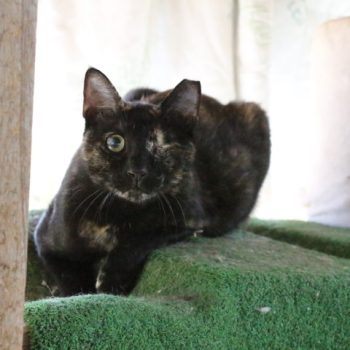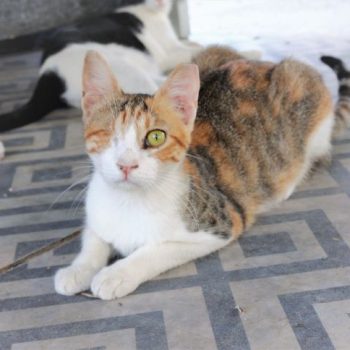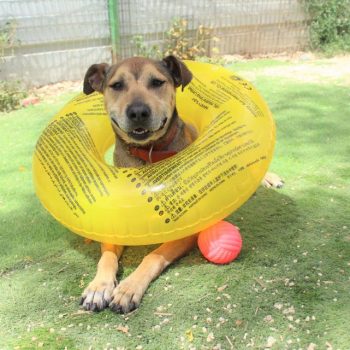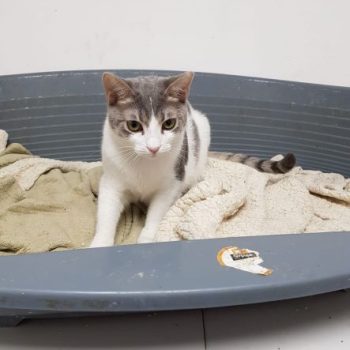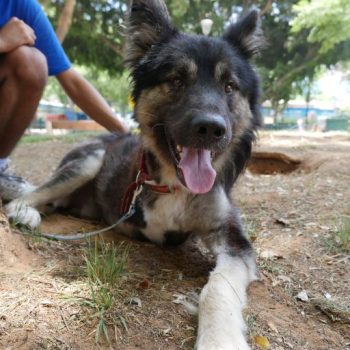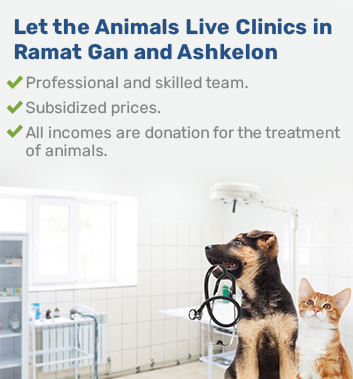|
By: Rivi Mayer, Cat Welfare Expert
They live alongside us, in each of our neighborhoods, in our workplace. This is their home! You don’t have to love them – but you have to respect their lives alongside us and try to help them live as long as possible. They will not disappear from themselves (although some pray for it…), a cat is a territorial animal and where he was born there will remain. What his life will look like – it’s already up to us. They didn’t choose to live on the street, but the fact is that currently over 2 million cats are forced to try and survive on our streets. They’re vulnerable to abuse, run over on the roads, die of thirst and terrible hunger. The closed garbage cans, not only are no longer a food source for them, they have also become a danger to them. In the sweltering July and August, with no accessible drop of water, they’re just dying a terrible death. In winter, hundreds of kittens born into street life, don’t survive the cold and wetness. The cats on the street live in groups of 15-25 around shelter and food sources – sometimes near garbage cans and/or casual food, and in a preferred manner, of course, alongside a person or several people who feed them regularly every day at a set time with food and water alongside it. A cat is a territorial animal – that means, they live in a defined physical area for them, protecting it from invaders such as rodents, snakes, etc. The resources that exist in a certain area and the attitude of man to them, are those that will allow cats to live and do their job (“the sanitary of nature”) for many years (up to 20 years, just like the lifespan of a cat living indoors) with dignity and alongside human beings, or when there is a lack of resources – their fate is, god forbid, to be a nuisance, to be persecuted, miserable, starved, sick and of course give birth to countless kittens born to a life of disease and suffering. Of course, healthy cats – spayed/neutered, who receive food regularly – are those who will do their job for man and his environment, optimally. The cats on the street are part of human life and are an ecological niche in itself, which the duty of man is to strengthen and to preserve – for his benefit, for the benefit of the environment and of course for the benefit of the cats – which from their side return a protected and safe environment for human beings. The people who take care of the cats on the street and who care for them for food, water, shelter and protection – are the ones that with their help it is possible to cope in the correct, real, legal and long-term manner, when it comes to the lives of the cats on the street, in reference to their own fate and to people who do not like the annoyances resulting from the cats not being spayed/neutered. The cats on the street are a blessing for the environment. Nuisances associated with cats on the street – which do not receive food and water regularly, and which are not spayed/neutered – are the focal point of neighbors’ conflicts, and of course the cause for great suffering for the cats themselves and for the people who care for them. The essence of nuisances: howling, multiplying and harassing Females – frequent heat cycles (2-3 a year!! starting at 5 months age! every year until her death in suffering). Endless giving births (in each litter – 4-6 kittens). A female may also be pregnant during nursing! And she’s pregnant from multiple males at the same time. Very rare is a state of infertility in females and males!! All females and males are fertile from the age of 5-6 months until their difficult and unnatural deaths (almost always – on the road, from diseases, injuries, hunger and harassment by people and dogs). Males – Heat cycles that last intermittently for 10 months each year! Howling at night mainly, urinating acute urine for marking, fierce fights between males and street chases – including after females, which cause injuries and deaths in accidents. Kittens – catching diseases already in their mother’s womb due to the severe physical condition of females who give birth from the age of 5 months and every two months without ending, until their severe death. Born with viruses in the upper respiratory tract, which cause, in many cases, severe eye infections and blindness as well as deadly pneumonia, and with severe viruses which cause chronic diseases, if they survive the infancy period. The kittens are abandoned by the starving mother, who becomes pregnant during the nursing period, to make way for the new kittens. Two-month-old kittens are required to locate food for themselves – with the vast majority of them in a serious physical condition. Kittens are being run over in bulk and also getting stuck on traffic islands and other crowded places, due to the fact that they are trying to follow their mother, who is already busy with another pregnancy. Kittens are easy prey for children, dogs and of course the cruelty of people. Females and kittens are caught, often after giving birth, into apartments, schools, shelters and other places – which constitute temporary shelter for them, but a death trap over time. All these problems completely disappear– when you take care to spay and neuter every cat (male and female) on the street, and the beginning is always with the help of organized and regular feeding by people who take care of the cats.
How do you feed and treat right? Timing – it is recommended to choose a fixed time (more or less, that is – at a difference of about two hours at most) so that the cats will not sit and wait for us all day and be exposed to the dangers of the street –recommended very early in the morning or very late in the evening. The number of feedings – once every 24 hours! Feeding point location – recommended far from the eyes of the neighbors! Quiet, hidden and protected location for the cats and the food. The food –recommended dry, fresh and high quality. You can add or give separately – for very young or older cats and/or those with mouth/dental problems – soft food and/or wet some of the dry food with water. If you have given wet food, please place it in a container. Wet food that dries brings with it a lot of flies. Food quality – please read the label on the packaging. It is recommended to purchase food containing chicken and/or fish as the first ingredient on the list. This type of food is expensive, but it will benefit the cats and you. A second option is food whose first ingredient is “chicken/fish flour”. Please know that food whose first ingredient is “corn” is poor food, so the cats will need a great amount of it in each feeding to satisfy their physical needs. Make your considerations and try to locate cat-feeders-friendly food stores on the street and also join other feeders (via the internet) to be in groups purchasing cat food for the purpose of discounting it for you. The amount of food– the quantity depends very much on the quality of the food. The higher the food quality is (and naturally its price), the less the cats will need from it to be satiated. Poor quality food (and very cheap respectively) does not satisfy the cats and requires a large amount of it in each feeding. In any case, please put plenty of dry food for cats and see how much remains until the next feeding time. If there is little leftover on the bottom of the bowl – this is the right amount. If there is no crumb – make sure to add to the basic amount, and if there is plenty of food in the bowl after 24 hours – cut back in quantity. Water – fresh and clean at every feeding time. Food and water bowls – they must be kept clean every single day and without any cracks! (Cracked bowls accumulate dirt and bacteria and are difficult to clean, and in addition – they do not exactly convey the message of “I love and care for cats”…) Cleaning the area – always keep it fully clean, for the health of the cats and of course for the environment and for the prevention of nuisances and neighbor disputes. Highly recommended – to stay near the cats (at a distance that allows them to behave freely and without fear) when eating, to make sure that everyone is indeed receiving food. It is important to see if there are cats who need feeding in a slightly more remote place (young and/or weak), and that should be taken care of during the regular feeding itself. It is also possible to see if there are any physiological problems that require veterinary attention (additional capture is sometimes necessary, but it is also possible to consult with an experienced veterinarian, and to give the required treatment within the food itself). Pay particular attention – to cats who have difficulty chewing (shouting, running away from the food and/or drooling), those who have lost weight prominently and of course those who behave exceptionally. If there are cats in your feeding corner that needs veterinary care and you can’t capture them – you can contact the municipal hotline (in your city) or the extrication and rescue center of “Let the Animals Live”. Try not to accustom the cats to human contact, if they don’t want it. Sociable cats to humans (and not just you) – might reach “bad hands”. If there are very sociable cats and especially when they are young – consider looking for a suitable permanent and loving home for them, and check whether they are suitable to live indoors (consult with cat behavior professionals).
Prohibitions – Prohibited under any circumstances The law forbids the transfer of cats from their places! Any transfer of a cat from the street to another area (without an experienced professional escort) – is a death sentence! It is forbidden to throw food out of the window/balcony. Feeding with leftovers is prohibited – it is dangerous, and especially risky are bones! And of course – it is forbidden to stop feeding cats, which are used to it every day! That’s extremely cruel. It is absolutely mandatory – to locate additional feeders on the street / in the building / in the settlement – and to make sure that there is always a substitute feeder, when the regular feeder is either sick or on vacation and absent from home. Very important – remember that feeding is a responsibility for many years and if you live in a rented apartment or intend to live in your apartment only for a short time, it is better to help a local feeder with both feedings and food donations and in addition – of course, to perform spaying and neutering for all the cats in your yard, but do not feed them regularly and exclusively, because they will be lost and starved when you will move apartment and leave them alone without a food source. If there is no feeder in the vicinity, then organize a feeding area and encourage other people who live in the area to participate with you in feeding. Organizing before trapping for sterilization – even if you do not feed regularly: you can feed the cats a few days before the arrival of the “licensed pro” for the purpose of spaying/neutering, in order to arrange the cats’ arrival at a fixed time to a fixed location, and also a few days after their return to help them recover from the surgeries. But – if you are not sure that there is another regular feeder, it is forbidden to feed regularly when living in a rental. Cats that get used to regular feeding – do not know about other food sources, and when moving from one apartment to another – the cats will starve!! It is possible, of course, to feed once every three days or so, even when living in a rented apartment, provided that all the cats in the vicinity are spayed/neutered, in order to prevent new litters. It is important and recommended to help regular feeders in the region, and of course to take care of the spaying and neutering in your place of residence, even without regular feeding.
Dealing with problems People, neighbors and bystanders – it is important to avoid any friction with them in the first place. Feeding in a place far from the eyes of the neighbors and at a regular time (very early or very late) will usually prevent unnecessary friction. However, keep in mind that there is no law prohibiting the feeding of cats, and therefore if you have encountered a problem with a neighbor, you can contact the Legal Department of “Let the Animals Live”. Performing spaying and neutering will prevent any nuisance, and in fact the cats will become invisible and will do their job for the environment fully. It is important to explain the importance of cats to the environment – and the fact that they are clean and healthy animals – to any interested person. It is also possible to attach “positive” neighbors to the feeding round and to involvement in the treatment of cats. If there are questions and/or claims – It is recommended to use written and printed material from the Internet regarding the importance of cats on the street and their legal rights to life! It is imperative to make it clear to the neighbors that it is forbidden to cause any harm to cats –according to the law – and also spilling food/water and of course any harm to them or, God forbid, capture and abandonment in a remote location – are serious criminal offenses punishable by imprisonment! It is possible to be assisted by the Legal Department of “Let the Animals Live” to get a letter clarifying the rights of the cats and the people who feed them – in any case of questions from the neighbors. It is important to clarify the legal place of the cats and their being an important part of the quality of life of all of us! It is very important – to do all the activity in front of the neighbors in a positive, pleasant and respectful manner. Neighbors who want to quarrel – refer written material to them – avoid quarreling with them and protect the cats from these people. Dogs – Sometimes some are freely released for a night run, and some among them tend to chase cats and/or eat their food. Try to locate the owners of these dogs and ask them pleasantly to keep their dogs with them at all times. Speak to their hearts and tell them about the famine of the cats and their plights, which you do all you can to resolve. If these people are hostile – contact the Legal Department of “Let the Animals Live” for the protection of the cats and advice on the subject. Remember – feeding orderly and regularly alongside the execution of spaying/neutering and prevention of all litter – are the most right, recommended, legal and efficient way for the benefit of the cats on the street. The cats on the street are an asset to man – and you, the feeders, are the way to a better life for the cats and for all of us as well.
To print the Guide
Important connections and links “Let the Animals Live” – a spaying and neutering clinic at a reduced price and of high quality and sometimes free deals!! Trapping for bringing unsociable cats for spaying, neutering and treatments www.letlive.org.il 03-6241776 The Cat-related Facebook pages are a great source for connection, mutual advice and support: “The face of cat feeders on the street” is an excellent page. Also visit the page “Cats and Enjoy”, and much more. Other options for contacts with feeders in your community: try to locate the local association in your area, for the benefit of cats on the street – look for the lovely people and join them. If you live in a community that has not yet established a similar association – contact and look for other good people – and set up an association together, which will take care of the street cats in your locality, by contacting the local authority for the allocation of funds and resources. (Associations in Kfar-Saba, Ra’anana, Herzliya, Rishon LeZion, Jerusalem and more – are an example and you can use their people to establish the same activity in your community!) National and Local Associations for Animals Great sites to get information about feeding and sterilizations, and taking care of cats on the street in general: And abroad
Remember – find people who love the cats on the street in your community, and help each other – Together is strength: for your sake, for the sake of the cats and for the environment in your area! Don’t wait for others to help the cats – get up and do it yourself – for their sake! Good luck!!!
|
||
|
10/08/2016




